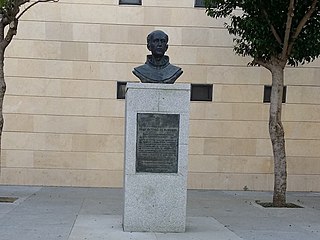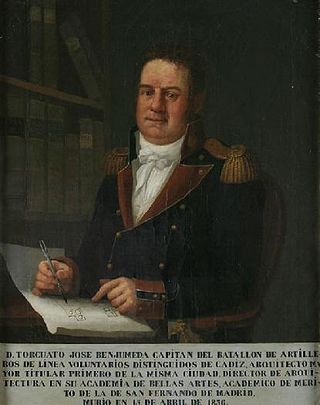Related Research Articles

Doñana National Park or Parque Nacional y Natural de Doñana is a natural reserve in Andalusia, southern Spain, in the provinces of Huelva, Cádiz and Seville. It covers 543 km2 (209.65 sq mi), of which 135 km2 (52.12 sq mi) are a protected area. It is named after Doña Ana de Silva y Mendoza, wife of the 7th Duke of Medina Sidonia.

The Guadalquivir is the fifth-longest river in the Iberian Peninsula and the second-longest river with its entire length in Spain. The Guadalquivir is the only major navigable river in Spain. Currently it is navigable from Seville to the Gulf of Cádiz, but in Roman times it was navigable from Córdoba.

The University of Seville is a university in Seville, Andalusia, Spain. Founded under the name of Colegio Santa María de Jesús in 1505, in 2022 it has a student body of 57,214, and is ranked 6th among Spanish universities.

The Sierra Morena is one of the main systems of mountain ranges in Spain. It stretches for 450 kilometres from east to west across the south of the Iberian Peninsula, forming the southern border of the Meseta Central plateau and providing the watershed between the valleys of the Guadiana to the north and the west, and the Guadalquivir to the south.

Santa Cruz de Mudela is a municipality of the Spanish Province of Ciudad Real located in the southeastern corner of the autonomous community Castilla–La Mancha.

The governor, according to the Political Constitution of the Free and Sovereign State of Veracruz de Ignacio de la Llave in Mexico, the Executive Power is invested in one individual, called "Constitutional Governor of the Free and Sovereign State of Veracruz de Ignacio de la Llave". The current governor is Rocío Nahle García, who assumed the position on December 1, 2024. She is a member of the National Regeneration Movement and the first woman to hold the office.
Aznalcázar is a town located in the province of Seville, southern Spain. It is only 20 minutes away from Seville, and is one of the 13 towns located in Doñana National Park, one of Spain's most important national parks and wildlife reserves.
Olivares is a city located in the Province of Seville, Spain. According to the 2016 census (INE), the city has a population of 9480 inhabitants. It is located in the Aljarafe, the comarca downstream of the Guadalquivir and west of Seville. It borders Albaida to the west, Gerena to the north, Salteras to the east, and Sanlúcar la Mayor and Villanueva del Ariscal to the south. After the establishment of the House of Olivares, it grew in size and influence, becoming an important urban center in the Aljarafe.

The Germani were an obscure pre-Roman ancient people of the Iberian Peninsula which settled around the 4th century BC in western Oretania, an ancient region corresponding to the south of Ciudad Real and the eastern tip of Badajoz provinces.
Eloísa Gómez-Lucena is a Spanish contemporary writer.

The Cathedral of the Incarnation is a Roman Catholic cathedral in Guadix, Spain. Construction began during the 16th century and was completed by the mid-18th century. It is the seat of the Diocese of Guadix.

Antonio de San Buenaventura y Olivares or simply Fray Antonio de Olivares was a Spanish Franciscan who officiated at the first Catholic Mass celebrated in Texas, and he was known for contributing to the founding of San Antonio and to the prior exploration of the area. He founded, among other missions, the Alamo Mission in San Antonio, the Presidio San Antonio de Bexar, and the Acequia Madre de Valero.
Cándido Cartón was a Spanish executioner of the Audiencia de Sevilla (1936-39) and Audiencia Nacional (1940-49).

Torcuato José Benjumeda y Laguada was a Spanish architect. A disciple of Torcuato Cayón, he was one of the most important Neoclassical architects in Andalusia, designing several of the most prominent buildings in Cádiz. These include the Royal Prison, the Church of St. Peter and St. Paul and the Ayuntamiento.

Marquess of Portago is a hereditary title in the Peerage of Spain accompanied by the dignity of Grandee, granted in 1744 by Philip V to José Gómez de Terán y Delgado, Finance Treasurer and Council Minister of Spain.

Cerro del Villar, located in the mouth of Guadalhorce river, southern Spain, was a Phoenician city founded in the ninth century BC or eighth century BC. It was abandoned possibly in 584 BC. Since 2003, there have not been any archeological excavations. Previous excavations were directed by María Eugenia Aubet.

The Cemetery of San Fernando is located in the San Jerónimo district, north of the city of Seville, Andalusia, Spain. It was built in 1852, and it is the only municipal cemetery in the city. It has an area of 28 hectares and is considered as one of the most famous cemeteries in Spain.
The 82nd Mixed Brigade was a unit of the Spanish Republican Army created during the Spanish Civil War. It came to operate on the Teruel and Levante fronts.
Laelia was an ancient city located in the Cerro de la Cabeza near Olivares in the Province of Seville, Spain. Originally a Tartessian settlement, it was named Laelia by Roman settlers in the 2nd century BC. It was described by Pliny the Elder in his Natural History as lying on the Menoba River (Guadiamar) near the towns of Olontigi and Lastigi. These three cities had their own mints and, thus, are well attested from numismatic evidence. Their exact location, however, has not been definitively established. All three were probably located relatively close to Aznalcóllar, where the materials for their coins were probably mined. The settlement at the Cerro de la Cabeza, populated until the 13th century, most likely corresponds to Laelia given the archaeological evidence obtained from excavations in 1981.
The 37th Goya Awards ceremony, presented by the Academy of Cinematographic Arts and Sciences of Spain, took place at the FIBES Conference and Exhibition Centre in Seville, Andalusia on 11 February 2023.
References
- ↑ Caro, Rodrigo (1634). Antigüedades, y principado de la ilustrissima ciudad de Sevilla: y chorographia de su convento jurídico, o antigua chancillería (in Spanish). Seville, Spain. p. 185. ISBN 978-84-300-8296-4.
- ↑ Cortés y Lopéz, Miguel (1835). Diccionario geografico-historico de la España Antigua Tarraconense, Betica y Lusitana: con la correspondencia de sus regiones, ciuades, montes, rios, caminos, puertos e islas a las conocidas en nuestros dias (in Spanish). Madrid, Spain: Imprenta Real. p. 260.
- ↑ Delgado, Antonio (1871). "Olontigi". Nuevo método de clasificación de las medallas autónomas de España (in Spanish). J. R. Cayón. p. 239. ISBN 978-84-400-9306-6.
- ↑ Mateos Gago, Francisco (1871). "Lastigi". In Delgado, Antonio (ed.). Nuevo método de clasificación de las medallas autónomas de España (in Spanish). J. R. Cayón. p. 178. ISBN 978-84-400-9306-6.
- ↑ Piñol, Juan Cuveiro (1891). Iberia protohistórica y rectificaciones de algunos hechos históricos. Valladolid, Spain.
{{cite book}}: CS1 maint: location missing publisher (link) - ↑ Villaronga, Leandre (1994). Corpus nummum Hispaniae ante Augusti aetatem (in Spanish). Madrid, Spain. p. 380.
{{cite book}}: CS1 maint: location missing publisher (link) - 1 2 3 4 5 Rufino, Antonio Caballos; Carrasco, José Luis Escacena; Tristán, Francisca Chaves (2005). "Identificación toponínima del Cerro de la Cabeza". Arqueología en Laelia, Cerro de la Cabeza, Olivares, Sevilla: campaña de excavación de 1981 (in Spanish). Universidad de Sevilla. pp. 43–56. ISBN 978-84-472-0812-8.
- ↑ Ortiz de Urbina, Estíbaliz (1996). Teoría y práctica del ordenamiento municipal en Hispania: actas del Symposium de Vitoria-Gasteiz (22 a 24 de Noviembre de 1993) (in Spanish). Universidad del País Vasco. p. 205. ISBN 978-84-7585-856-2.
- ↑ de Hoz, Javier (2010). Historia lingüística de la Península Ibérica en la Antigüedad: Preliminares y mundo meridional prerromano (in Spanish). Editorial CSIC. p. 325. ISBN 978-84-00-09276-4.
- ↑ Muñoz, Paco (21 April 2024). "La huella de Lastigi: Una ciudad tartésica enterrada bajo el Campo de Tejada". Huelva Información (in Spanish). Retrieved 11 December 2024.